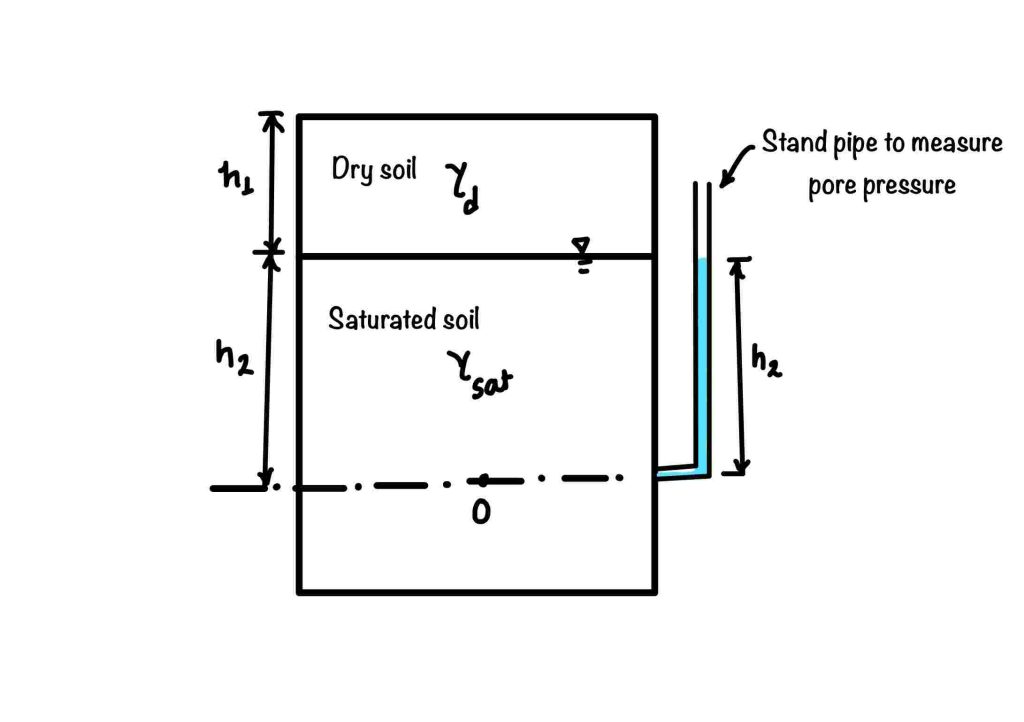Effective stress is the main parameter that helps understand soil engineering phenomena. Although effective stress is hypothetical, and there is no instrument to measure this directly, it is still most helpful in predicting soil behaviour. In this post, you will learn what effective stress is, how to measure this and how effective it is in predicting soil behaviour.
What is effective stress?
Soil consists of solid water and air. The transfer of force occurs through particle-to-particle interaction. For the explanation of this concept, we take one example. The figure shows the dry soil of height \(h_1\) and saturated sand of height \(h_2\) above the point \(O\) under consideration.

The calculation of the following parameters for the given case.
- Total stress: Total stress is the total solid plus water pressure.$ \sigma=\gamma_d\times h_1+\gamma_{sat}\times h_2 $
- Pore pressure: Water inside the pores of the soil creates pore pressure. It is also known as neutral stress because it applies equal stress in all directions.$ u = h_2\times\gamma_w $
- Effective stress: Effective stress remains after deducting the pore pressure from total stress. Physically it is the stress transfer from grain to grain in the downward direction.
$$ \overline{\sigma}= \sigma-u\\ \overline{\sigma}= \gamma_d\times h_1+(\gamma_{sat}-\gamma_w)\times h_2\\\overline{\sigma}= \gamma_d\times h_1+\gamma’\times h_2$$
How to measure the effective stress in soil?
As we have discussed, it is not real or measurable. To calculate the effective stress in the soil, we first need to measure the total stress and then pore pressure with the help of standpipes. Then, using the relation shown in the equation below, we can calculate the effective stress in the soil.
$$ \overline\sigma = \sigma – u $$
where $\overline{\sigma}$ is effective stress, $\sigma$ is the total stress and $u$ is the pore pressure or neutral stress.
Effective stress is a crucial parameter responsible for the soil's compaction and shear strength.
The physical significance of effective stress
Unlike continuum, material soil is the particulate material. It transfers the load from particle to particle, as shown in the figure. Force divided by the contact area is the actual stress transferred in the soil. This stress is far more than the effective stress we are calculating by using the total area of the soil. Although it is not exact in the calculation, it has been proved to be a very important parameter from experiments. It is relevant in soil compaction, volume reduction, shear strength, and other engineering properties.
Conclusions
From the above discussion, it is a very effective parameter in soil behaviour. This parameter is responsible for soil compaction, shear strength, and failure.
If you have gone through the post, you have the following learning points.
- Effective stress: For soil it is total stress minus pore water pressure.
- Effectiveness of effective stress: It is responsible for the soil’s compaction and shear strength.

Android Apps
⭐️ ⭐️ ⭐️ ⭐️ ⭐️ 1000+ | 400,000 + Downloads (Cumulative)
At eigenplus, our goal is to teach civil engineering students about structural analysis and design starting from the fundamental principles. We do this with the help of interactive android applications and accompanying web articles and videos.
Our apps have helped more than 400 thousand students across the world to understand and learn the concepts of structural engineering. Check out our apps on the google play store.
This article was crafted by a group of experts at eigenplus to ensure it adheres to our strict quality standards. The individuals who contributed to this article are:
Author


